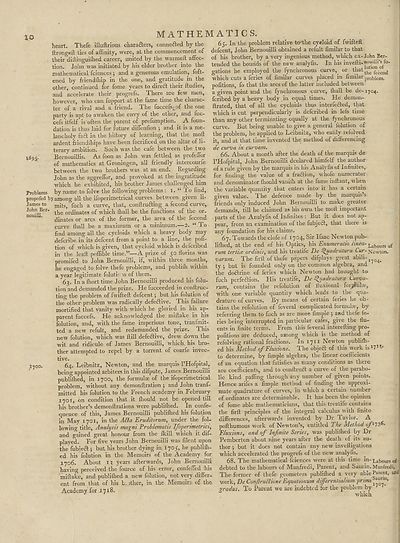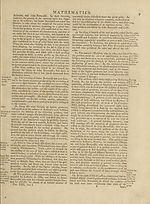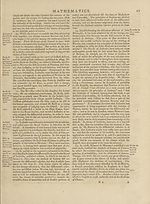Encyclopaedia Britannica, or, a Dictionary of arts, sciences, and miscellaneous literature : enlarged and improved. Illustrated with nearly six hundred engravings > Volume 13, MAT-MIC
(18) Page 10
Download files
Complete book:
Individual page:
Thumbnail gallery: Grid view | List view

io
MATHEMATICS.
heart. Thefe illuftrious cliara&ers, connefted by the
ftrongeft ties of affinity, were, at the commencement of
their diftinguiffied career, united by the warmed affec-
John was initiated by his elder brother into the
tion.
Janies to
John Ber
nouilli.
mathematical fciences 5 and a generous emulation, foft
ened by friendffiip in the one, and gratitude in the
other, continued for fome years to direft their ftudies,
and accelerate their progrefs. There are few men,
however, who can fupport at the fame time the charac¬
ter of a rival and a friend. The fuccefv of the one
party is apt to awaken the envy of the other, and fuc-
cefs itfelf is often the parent of prefumption.. A foun¬
dation is thus laid for future diffenfion ; and it is a me¬
lancholy fa61 in the hiltory of learning, that the mod
ardent frienddiips have been facrificed on the altar of li¬
terary ambition. Such was the cafe between the two
X(S9-. Bernouillis. As foon as John was fettled as profeffior
of mathematics at Groningen, all friendly intercourfe
between the two brothers was at an end. Regarding
John as the aggreifor, and provoked at the ingratitude
which he exhibited, his brother James challenged him
Problems byname to folve the following problems : I. ‘‘ lo find,
propofed by among all the ifoperimetrical curves bet ween given li-
T “ mits, fuch a curve, that, condru&ing a fecond curve,
the ordinates of which diall be the fun&ions of the or¬
dinates or arcs of the former, the area of the fecond
curve diall be a maximum or a minimum.—2. “ To
find among all the cycloids which a heavy body may
defcribe in its defcent from a point to a line, the pofi-
tion of which is given, that cycloid which is defcribed
in the lead poffible time.”—A prize of 50 florins was
promifed to John Bernouilli, if, within three months,
he engaged to folve thefe problems, and publifli within
a year legitimate folutir is of them.
63. In a ffiort time John Bernouilli produced his folu-
tion and demanded the prize. He fucceeded in conflruc-
ting the problem of fwifted defcent; but his folution of
the other problem wras radically defective. This failure
mortified that vanity with which he gloried in his ap¬
parent fuccefs. He acknowledged the miflake in his
folution, and, with the fame imperious tone, tranfmit-
ted a new refult, and redemanded the prize. This
new folution, which was dill defedlive, drew down the
wit and ridicule of James Bernouilli, which, his bro¬
ther attempted to repel by a torrent of coarfe invec-
tive.
3700. 64. Leibnitz, New-ton, and the marquis THofpital,
being appointed arbiters in this difpute, James Bernouilli
publiffied, in 1700, the formulae of the ifoperimetrical
problem, without any demondration ; and John tranf-
mitted his folution to the French academy in February
1701, on condition that it ftiould not be opened till
his brother’s demondrations were publidied. In confe-
quence of this, James Bernouilli publiflied his folution
in May 1701, in the Acia Eruditorum, under the fol¬
lowing title, Analysis magni Problematis Ifoperimetrici,
and gained great honour from the fkill which it dif-
played. For five years John Bernouilli was filent upon
the fubieft ; but his brother dying in 1705, he publifli¬
ed his folution in the Memoirs of the Academy for
1706. About 13 years afterwards, John Bernouilli
having perceived the fource of his error, confe-Ted his
miflake, and publiftied a new folution, not very differ¬
ent from that of his t-other, in the Memoirs of the
Academy for 1718.
65. In the problem relative toThe cyeloid of Iwifteii
defcent, John Bernouilli obtained a refult fimilar to that
of his brother, by a very ingenious method, which ex-John Ber-
tended the bounds of the new analyfis. In his invefti-
gations he employed the fynchronous curve, or that
which cuts a feries of fimilar curves placed in fimilar probiem.
politions, fo that the arcs of the latter included between
a given point and the fynchronous curve, ffiall be de- 1704,
fcribed by a heavy body in equal times. He demon-
flrated, that of all the cycloids thus interfe6led, that
which is cut perpendicularly is defcribed in lefs time
than any other terminating equally at the fynchronous
curve. But being unable to give a general folution of
the problem, he applied to Leibnitz, who ealily refolyed
it, and at that time invented the method of differencing
de curva in curvam.
66. About a month after the death of the marquis de
I’Hofpital, John Bernouilli declared himfelf the author
of a rule given by the marquis in his x\nalyfis of Infinites,
for finding the value of a fra6fion, whole numerator
and denominator fliould vaniffi at the fame inftant, when
the variable quantity that enters into it has a certain
given value. The defence made by the marquis’s
friends only induced John Bernouilli to make greater
demands, till he claimed as his own the mod important
parts of the Analyfis of Infinites : But it docs not ap¬
pear, from an examination of the fubje6i, that there is
any foundation for his claims.
67. Towards the clofe of 1704, Sir Ifaac Newton pub¬
liflied, at the end of his Optics, his Enumeratio linea- Labours ,3?
rum tertue or dims ^ and his treatife Ee ^uadratura Cur- Newton.
varum. The fird of thefe papers difplays great abili-^^
ty •, but is founded only on the common algebra, and '
the doefrine of feries which Newton had brought to
fuch perfe£Hon. His treatife, De Quadratura Curvu-
rum, contains the refolution of fluxional forpiSulaj,
with one variable quantity which leads to the qua¬
drature of curves. By means of certain feries he ob¬
tains the refolution of feveral complicated formulae, by
referring them to fuch as are more Ample 5 and thele le-
ries being interrupted in particular cafes, give the flu¬
ents in finite terms. From this feveral intereding pro-
pofitions are deduced, among which is the method of
refolving rational fraaions. In 1711 Newton publifti¬
ed his Method of Fluxions. The objea of this work is1?11-*
to determine, by Ample algebra, the linear coefficients
of an equation that fatisfies as many conditions as there
are coefficients, and to condrua a curve of the parabo¬
lic kind paffing through any number of given points.
Hence arifes a fimple method of finding the approxi¬
mate quadrature of curves, in which a Certain number
of. ordinates are determinable. It has been the opinion
of fome able mathematicians, that this treatife contains
the firft principles of the integral calculus with finite
differences, afterwards invented by Dr Laylor. A
pod humous work of Newton’s, entitled Fhe Method ofl12>6.
Fluxions, and of Infinite Scries, was publiflied by Dr
Pemberton about nine years after the death of its au¬
thor •, but it does not contain any new invefligations
which accelerated the progrefs of the new analyfis.
68. The mathematical fciences were at this time hi-jjabours 0f
debted to the labours of Manfredi, Parent, and Saurin.Manfredi,
The former of thefe geometers publiflied a very able Parent, and
work, De Confiruclione Equationum differentialium primi
gradus. To Parent we are indebted for the problem by 1
MATHEMATICS.
heart. Thefe illuftrious cliara&ers, connefted by the
ftrongeft ties of affinity, were, at the commencement of
their diftinguiffied career, united by the warmed affec-
John was initiated by his elder brother into the
tion.
Janies to
John Ber
nouilli.
mathematical fciences 5 and a generous emulation, foft
ened by friendffiip in the one, and gratitude in the
other, continued for fome years to direft their ftudies,
and accelerate their progrefs. There are few men,
however, who can fupport at the fame time the charac¬
ter of a rival and a friend. The fuccefv of the one
party is apt to awaken the envy of the other, and fuc-
cefs itfelf is often the parent of prefumption.. A foun¬
dation is thus laid for future diffenfion ; and it is a me¬
lancholy fa61 in the hiltory of learning, that the mod
ardent frienddiips have been facrificed on the altar of li¬
terary ambition. Such was the cafe between the two
X(S9-. Bernouillis. As foon as John was fettled as profeffior
of mathematics at Groningen, all friendly intercourfe
between the two brothers was at an end. Regarding
John as the aggreifor, and provoked at the ingratitude
which he exhibited, his brother James challenged him
Problems byname to folve the following problems : I. ‘‘ lo find,
propofed by among all the ifoperimetrical curves bet ween given li-
T “ mits, fuch a curve, that, condru&ing a fecond curve,
the ordinates of which diall be the fun&ions of the or¬
dinates or arcs of the former, the area of the fecond
curve diall be a maximum or a minimum.—2. “ To
find among all the cycloids which a heavy body may
defcribe in its defcent from a point to a line, the pofi-
tion of which is given, that cycloid which is defcribed
in the lead poffible time.”—A prize of 50 florins was
promifed to John Bernouilli, if, within three months,
he engaged to folve thefe problems, and publifli within
a year legitimate folutir is of them.
63. In a ffiort time John Bernouilli produced his folu-
tion and demanded the prize. He fucceeded in conflruc-
ting the problem of fwifted defcent; but his folution of
the other problem wras radically defective. This failure
mortified that vanity with which he gloried in his ap¬
parent fuccefs. He acknowledged the miflake in his
folution, and, with the fame imperious tone, tranfmit-
ted a new refult, and redemanded the prize. This
new folution, which was dill defedlive, drew down the
wit and ridicule of James Bernouilli, which, his bro¬
ther attempted to repel by a torrent of coarfe invec-
tive.
3700. 64. Leibnitz, New-ton, and the marquis THofpital,
being appointed arbiters in this difpute, James Bernouilli
publiffied, in 1700, the formulae of the ifoperimetrical
problem, without any demondration ; and John tranf-
mitted his folution to the French academy in February
1701, on condition that it ftiould not be opened till
his brother’s demondrations were publidied. In confe-
quence of this, James Bernouilli publiflied his folution
in May 1701, in the Acia Eruditorum, under the fol¬
lowing title, Analysis magni Problematis Ifoperimetrici,
and gained great honour from the fkill which it dif-
played. For five years John Bernouilli was filent upon
the fubieft ; but his brother dying in 1705, he publifli¬
ed his folution in the Memoirs of the Academy for
1706. About 13 years afterwards, John Bernouilli
having perceived the fource of his error, confe-Ted his
miflake, and publiftied a new folution, not very differ¬
ent from that of his t-other, in the Memoirs of the
Academy for 1718.
65. In the problem relative toThe cyeloid of Iwifteii
defcent, John Bernouilli obtained a refult fimilar to that
of his brother, by a very ingenious method, which ex-John Ber-
tended the bounds of the new analyfis. In his invefti-
gations he employed the fynchronous curve, or that
which cuts a feries of fimilar curves placed in fimilar probiem.
politions, fo that the arcs of the latter included between
a given point and the fynchronous curve, ffiall be de- 1704,
fcribed by a heavy body in equal times. He demon-
flrated, that of all the cycloids thus interfe6led, that
which is cut perpendicularly is defcribed in lefs time
than any other terminating equally at the fynchronous
curve. But being unable to give a general folution of
the problem, he applied to Leibnitz, who ealily refolyed
it, and at that time invented the method of differencing
de curva in curvam.
66. About a month after the death of the marquis de
I’Hofpital, John Bernouilli declared himfelf the author
of a rule given by the marquis in his x\nalyfis of Infinites,
for finding the value of a fra6fion, whole numerator
and denominator fliould vaniffi at the fame inftant, when
the variable quantity that enters into it has a certain
given value. The defence made by the marquis’s
friends only induced John Bernouilli to make greater
demands, till he claimed as his own the mod important
parts of the Analyfis of Infinites : But it docs not ap¬
pear, from an examination of the fubje6i, that there is
any foundation for his claims.
67. Towards the clofe of 1704, Sir Ifaac Newton pub¬
liflied, at the end of his Optics, his Enumeratio linea- Labours ,3?
rum tertue or dims ^ and his treatife Ee ^uadratura Cur- Newton.
varum. The fird of thefe papers difplays great abili-^^
ty •, but is founded only on the common algebra, and '
the doefrine of feries which Newton had brought to
fuch perfe£Hon. His treatife, De Quadratura Curvu-
rum, contains the refolution of fluxional forpiSulaj,
with one variable quantity which leads to the qua¬
drature of curves. By means of certain feries he ob¬
tains the refolution of feveral complicated formulae, by
referring them to fuch as are more Ample 5 and thele le-
ries being interrupted in particular cafes, give the flu¬
ents in finite terms. From this feveral intereding pro-
pofitions are deduced, among which is the method of
refolving rational fraaions. In 1711 Newton publifti¬
ed his Method of Fluxions. The objea of this work is1?11-*
to determine, by Ample algebra, the linear coefficients
of an equation that fatisfies as many conditions as there
are coefficients, and to condrua a curve of the parabo¬
lic kind paffing through any number of given points.
Hence arifes a fimple method of finding the approxi¬
mate quadrature of curves, in which a Certain number
of. ordinates are determinable. It has been the opinion
of fome able mathematicians, that this treatife contains
the firft principles of the integral calculus with finite
differences, afterwards invented by Dr Laylor. A
pod humous work of Newton’s, entitled Fhe Method ofl12>6.
Fluxions, and of Infinite Scries, was publiflied by Dr
Pemberton about nine years after the death of its au¬
thor •, but it does not contain any new invefligations
which accelerated the progrefs of the new analyfis.
68. The mathematical fciences were at this time hi-jjabours 0f
debted to the labours of Manfredi, Parent, and Saurin.Manfredi,
The former of thefe geometers publiflied a very able Parent, and
work, De Confiruclione Equationum differentialium primi
gradus. To Parent we are indebted for the problem by 1
Set display mode to:
![]() Universal Viewer |
Universal Viewer | ![]() Mirador |
Large image | Transcription
Mirador |
Large image | Transcription
Images and transcriptions on this page, including medium image downloads, may be used under the Creative Commons Attribution 4.0 International Licence unless otherwise stated. ![]()
| Permanent URL | https://digital.nls.uk/192661396 |
|---|
| Attribution and copyright: |
|
|---|
| Description | Ten editions of 'Encyclopaedia Britannica', issued from 1768-1903, in 231 volumes. Originally issued in 100 weekly parts (3 volumes) between 1768 and 1771 by publishers: Colin Macfarquhar and Andrew Bell (Edinburgh); editor: William Smellie: engraver: Andrew Bell. Expanded editions in the 19th century featured more volumes and contributions from leading experts in their fields. Managed and published in Edinburgh up to the 9th edition (25 volumes, from 1875-1889); the 10th edition (1902-1903) re-issued the 9th edition, with 11 supplementary volumes. |
|---|---|
| Additional NLS resources: |
|

